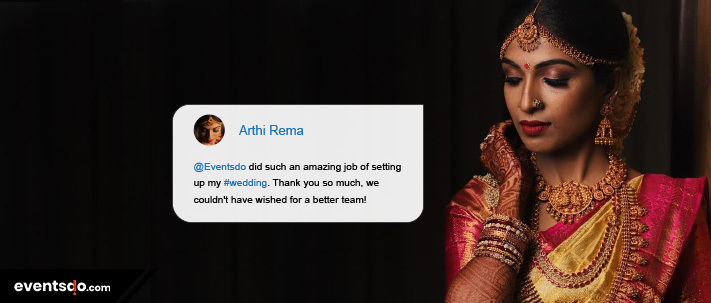How Eventsdo helped Arthi in Planning her Telegu Brahmin Wedding with Ease!
Everyone knows how tedious is it to plan and choose a proper professional for their big day. Arthi too had much confusion when it comes to choosing her perfect vendor. From prices to their availability and many more doubts like every other bride. Let’s get into it and know how eventsdo made it effortless.
Arthi approached us just a month before her wedding to inquire about the rates for stage decors and bridal makeup. With no time we have enquired about our premium vendors who are best suitable for her. As per her needs, we shortlisted and contacted them to know their availability for the date in such a short span. Luckily for her, three of our premium vendors were available for the dates. We right away shared their latest and best works to Arthi.
Arthi then sorted them according to her taste which she finds fittest for her Telegu Brahmin theme. She was then interested to include DJ & Shinkari Melam in her wedding which we had a variety of options in various price ranges. We helped her in finding and knowing the best rates in the market.
Bridal Makeup Artist: Vikas Vks Makeup Artist
Wedding Photography: Shiri Koneru
Let’s hear from her

Here are some great pictures of rituals at their wedding
SANGEETH:
This ceremony is performed at the bride’s house a few days before the wedding which involves families from both sides meeting and singing, an endeavor to make both sides more comfortable with each other. It is traditionally after the Mehendi ceremony, and involves a lot of fun, enthusiasm, and goodwill, merging with rituals. The songs usually hold meaningful lyrics that relate to the families and the members, and link to the importance of marriage.

THALIKETTU:
This is a part of the main wedding ceremony which involves giving the groom and his family members a proper warm welcome from the bride’s side. There are traditional music and prayer, and brass lamps are lit as the family is welcomed. The bride’s brother usually washes the groom’s feet and rituals and aarthi are carried out, after which the groom is seated in the mandap, followed by the bride at his side, who are led by either the father, maternal uncle or any female relative. As the muhurtam approaches, the groom ties the sacred ‘thali’ around the neck of the bride amidst the drum.

SNATHAKAM:
This is a ritual that is performed at the groom’s house where the groom is made to wear a silver holy thread as a symbol of the fact that he has ended his ‘Brahmacharya Vratha’ and is ready to start his new journey of ‘Grihastha’ with the marriage.
Related Blogs: 5 Amazing Temple Jewellery Designs We Spotted
JILAKARRA BELLAṂ AND MADHUPARKAṂ:
This is the ceremony during the actual muhurtham where the priest recites Shlokas from the Vedas, and the couple is asked to place a paste that is made from cumin seeds and jaggery on each other’s head to signify that the bond between the two.

TALAMBRALU:
This is the ritual where the bride and the groom sit facing each other and shower a mixture of turmeric, saffron, and rice (Talambralu) on each other to symbolize the playfulness that they share, while also depicting more serious aspects such as togetherness and their satisfied lives. M The wedding guests often encourage the couple to compete with each other while showering the Talambralu.

PELLIKOOTHURU/ PELLIKODUKU RITUAL:
This ritual involves the mixture of oil and turmeric paste is applied to the girl (known as Pellikoothuru) and the boy ( known as Pellikoduku) before marriage which is followed by the bride and groom taking showers and wear new clothes.

MEHENDI:
According to Hindu tradition, the Mehendi ceremony is mainly held at the bride’s house or at a banquet hall just a few days or even a day before the main wedding. Generally, the bride and groom attend the event together and on the occasion, a professional mehndi artist or a relative applies Mehendi to the bride’s hands and feet to form intricate, beautiful designs. Often, you will find hidden within the mehndi pattern, the name or initials of the groom. The event is generally festive and lively and involves the women dancing and singing traditional songs and the guests wearing bright, fun and vivid colors such as pinks, yellows, and orange.

Related Blogs: Top 10 Event Venues in Bangalore
BUTTA:
In traditional Telugu Brahmin weddings, the bride sits in a basket or butta and is carried to the mandap in the same basket by her mamas for the wedding ceremony. This is a very symbolic practice.

KANYADANAM:
This is the part of the ritual where the bride is taken to the ‘mandapam’ by her maternal uncles and placed in front of the groom and a curtain is held between the groom and the bride so that they cannot see each other. Then, the groom’s feet are placed on a large brass plate and washed by the bride’s parents as the priest begins chanting mantras, the groom receives 16 varieties of fruits from the bride’s parents from under the curtain and as the ‘sannai melam’ are on, the bride’s parents place the daughter’s hands (with a coconut) in the groom’s hands and perform Kanyadanam (donation of the daughter).

KASHI YATRA:
This part of the rituals involves the groom wearing new slippers, carrying an umbrella, a bamboo fan, a walking stick and a ‘grantha’ and pretending to be ready to go to Kashi for gaining further knowledge. Then, the bride’s brother stops him by requesting him to not go to Kashi for learning and offers him to marry his sister to begin the journey of ‘Grihastha’ where the groom is supposed to accept the proposal and return to the ‘mandapam’ to finish the ceremony.

If you want to make your wedding effortless Contact us: Call Now / Chat now
